|
|
||||||
|
Anson Finlay:
|
||||||
|
+ April 1, 1966 was Anson's first day at Raymond Moriyama Architects and Planners and September 22, 2006 was officially his last at Moriyama & Teshima Architects. After planning to come east for two years, forty plus years later he was still here. Anson was involved with many of the firms largest and most significant projects. And just as importantly, he was and always will be one of the defining personalities of the M&T office culture. To trace how Anson made his way to Moriyama & Teshima, we need to go back well over a hundred years. His descendants, who were of Scottish ancestry, left the lush countryside of County Wicklow in Ireland, south of Dublin, for Canada. Anson's parents were the children of homesteaders who settled in Saskatchewan in the early 1900's.
After grade one, the school boundaries in Saskatoon changed. Anson was separated from his buddies and sent to Victoria Public School with a whole new group of kids. There was a high level of anxiety going into this new situation, not unlike the feeling he has now preparing for retirement. His new teacher Miss Johnson was very inspirational and influential on him. She had stories of India, the Arctic, Holland and other exotic places. The back wall of the classroom was covered in brown paper that the students would draw on. The class were encouraged to use their imagination and open their eyes up to the world. All through public school, Anson preferred geography and history while participating in hockey and baseball. He was a member of the Victoria baseball team when they became city champs. While in high school, Anson joined the curling team and played football. When he was in grade twelve, the football squad took the provincial championship. For the last two years he took a drafting class and had summer jobs with building contractors. As high school was winding down, Anson began to consider his future. He almost applied to the University of Manitoba School of Architecture, but decided instead to stay within his home province to attend the University of Saskatchewan. Starting in the fall of 1957, Anson went into civil engineering, specializing in civil and structural. The University of Saskatchewan did not have their own football team so "Tiger" Finlay played with the Saskatoon Hilltops for three years. They went to the Canadian Junior Championships three years in a row, winning twice. For the playoffs, it meant a long two or three-day train trip to either Vancouver or Montreal. It was a good way to see the country each November and Anson recalls how long it took just to get through Ontario! Upon graduation with his BSc, Anson joined Crippen Wright Engineers from Vancouver who were involved in the design and construction of the Squaw Rapids Hydro Dam Project in northern Saskatchewan. He had gained experience the summer before working for the Saskatchewan Power Company while still a student. In 1961, Anson and Julia were married. After working with Crippen Wright for a year, Anson became aware of the new three-year post-graduate program in architecture at the University of British Columbia in Vancouver that was just starting up. Anson and Julia made the move to British Columbia. The fifteen students in the class included Ken Takeuchi who after graduation worked at Raymond Moriyama Architects and Planners. One year later, another future long-term M&T alumni, young Tom Motomochi enrolled in the program. Arthur Erikson was one of Anson's first year professors and he provided studio crits in later years. Ron Thom lectured at the school. Anson developed an appreciation for their sympathetic use of materials including wood, stone and concrete. During the summer after his second year, Anson won a traveling scholarship. He examined the urbanization of the north-eastern United States from Washington DC to Boston inspired by the ideas found in the book Megalopolis by John Gottman. One morning was spent with Louis Khan in his Philadelphia office. When the travel portion was over, a job at CMHC (Central Mortgage and Housing Corporation) in Ottawa occupied Anson for the remainder of the summer. With his Bachelor of Architecture from UBC in hand, Anson worked for three firms in Vancouver including Barrie Downs and Norm Jones. As a result of his previous travels to the east, and by observing the interesting projects being built there, Anson thought he would see if there were any employment opportunities. The plan was to go east for a couple of years and then return to the west.
As has been well documented in the past, Anson joined the firm of Raymond Moriyama Architects and Planners on April 1, 1966 while they were located in the lower level of 711 (now renumbered 717) Church Street. Ray was away at the time and David Vickers assigned his eager new recruit from the west his first project - The Renovation and Addition to 32 Davenport Road, the new home for the office. There were a few rough sketches as the design was still being finalized for the "workshop for the mind." Anson started on the working drawings and finalized the specifications with Chuck Sule. A contractor was chosen, W. G. How (Toronto) Limited, and the building permits were obtained. When Ray returned, the design was updated to add the Loft area. But there was a schedule problem. The space at 711 Church had to be vacated at the end of July and construction only started in June! Since it was impossible to meet the schedule, to avoid working on the sidewalk, the staff moved into the uncompleted building. We are still not sure if this involved getting an occupancy permit or not.
Work on the Centennial Centre for Science and Technology, we now know as the Ontario Science Centre, was underway and four people were working in the site office. There were about fifteen people in total on staff including Bon Mueller, Fred Brooks and Ken Takeuchi. During 1966 others who joined the firm were Mary Sabat, John Snell, Joni Inouye, Ted Teshima and Aubrey McIntosh. Don Cooper was coming and going at this time as well. On Aubrey's first day, December 12, 1966, the opening party for the new 32 Davenport offices was held. Anson and Bon Mueller took the office station wagon up to the Rouge Valley to get some large rocks to put around the outdoor fishpond. But it would not be a fishpond without fish! They could not find any koi, so they went down to Kensington Market and purchased a pail full of black carp which didn't last very long. In the spring of 1967 some koi were acquired. For Expo 70 in Osaka, Japan some koi were taken from Grenadier Pond over seas and put on display at the Canadian Pavilion. At the end of the fair, arranged through a friend of Ray's, some of these fish found a new home in the M&T fishpond. Through the late 1960's and early 1970's Anson become involved in numerous university projects including the University of Waterloo, the University of Guelph (working with Dr. John Powell was particularly rewarding), the Master Plan for Erindale College (University of Toronto Mississauga) with Ray Moriyama and Don Cooper, the Brock Academic Staging Building and the York University Fine Arts II Building.
But it was a return to his province of origin to work on the Meewassin Valley Project in Saskatchewan with Ray and George Stockton that brought it all home in the late 1970's. Canoeing down the South Saskatchewan River, past his old haunts that the planning study would preserve and enhance, made Anson understand and appreciate the process on both a personal and professional level. With the dawn of the 1980's, M&T were selected, along with associate architects Canon from Buffalo, to design the Buffalo Main Street Transit Mall which would put a new LRT transit line and a number of stations in the heart of the city. Anson worked on the team with Ray, Sheila Penny and Don Cooper. His work involved interfacing with three levels of government - City, State and Federal. Many trips were made across the border to Buffalo as the M&T staff became regulars at the Anchor Bar, the home of Buffalo Style Chicken Wings, and Sabres hockey games. The staff were exposed to "sloshball" by Canon - a derivative of baseball where every time you make a play you have to down an alcoholic drink. There were annual hockey matches between Canon and M&T, all won by M&T except the last one held in Oakville where Canon brought in some ringers from the United States Olympic Hockey team. Anson donned his unique hockey uniform of gray flannel pants, sometimes worn backwards. Working with Ted Teshima, many flights were taken to Chicago during the 10 South LaSalle (Chemical Plaza) project. In recalling satisfying projects, another was Science North in Sudbury. Working this time with the M&T team of Ray, Don Cooper and George Stockton and a very enthusiastic and high-energy client group led by Dr. David Pearson, made it a special experience. Not long after the opening of Science North in 1984, Ray, Anson, Sheila and Don worked on the initial proposals for the new Canadian Embassy that was to be built in Tokyo, Japan. Anson experienced the architecture and culture of Japan firsthand when he went over. One project that did not go ahead that Anson recalls was the Hong Kong History and Science Museum. It was a design competition and Anson spent time in Hong Kong and China before Margaret Thatcher canceled the project just as the design was completed. By 1986, work was beginning on the Ottawa-Carleton Regional Government Centre (now Ottawa City Hall). It became Anson's focus for the next three or four years. His follow-up project was the Bank of Montreal Institute for Learning. This was another positive client experience working closely with Matthew Barrett, Cory Jack and Eli Glied. In the early 1990's M&T actually won the commission to design a new engineering building at Anson's alma mater the University of British Columbia that unfortunately never did proceed much to his chagrin. Continuing to tackle large complex projects, Anson managed the TTC Leslie Station and Seneca@York. Anson made the shift in the mid-1990's to doing Contract Administration on a variety of projects like the McMaster University Centre, Holly Meadows and Willow Landing elementary schools in Barrie and later the TEL Building at York University, the Ryerson University Centre and YMCA's for both Durham and Markham. Today we know Anson as a world traveler, but having never been to Europe before, to celebrate his 40th birthday Anson took a month long trek by himself to Italy traveling by train through Torino, Milano, Venice, and Naples. During a later voyage to France in 1990 to visit his daughter who was living there at the time, he had a rendezvous at the Deux Magots, one the most famous cafés in Paris where Jean-Paul Sartre and Hemingway were both patrons in an earlier era, with Leslie Mohan (Moriyama) and her friend Dominique. Around this time an interest in tracing his Irish and Scottish ancestry started. Upon returning to Ireland and Scotland in 1998, accompanied by one of his long lost cousins now living in Australia, they searched through church archives in Ireland, found the location of the ancestral family farms in the Wicklow Hills and even stayed overnight at one of them.
Further enhancing Anson's status as a gourmet and food aficionado, for the past ten years the @M&T newsletter has featured "From The Kitchen of Anson Finlay." If you look back at early issues, the feature was but a few short paragraphs. In time the scope of the recipes and their related stories increased, so at times it appeared that the other @M&T content was supplemental to Anson's feature! We have learned how to barbeque bananas, the origins of the sandwich, how to prepare a deep fried Mars bar, how to barbeque a raccoon, the correct method to cook a meal by placing it on the engine block of your car while you drive, and that the mystery meat SPAM is perhaps the most versatile foodstuff ever created. Another little know fact about the @M&T newsletter is the origin of the name. When it was founded we had a contest but there was only one entry, and that was from Mr. Finlay. Now that he will have some more free time, Anson hopes to get back into playing the piano and may tackle learning to play the fiddle using his grandfather's 125 year-old instrument. Time will be spent on the golf course and return trips to "red rock country" in the south-western states of Utah and Arizona are in the planning stages. More frequent visits can be made to see son Graham and family in Calgary and daughter Catherine and her husband David and family in the Newmarket area. Anson has seven grandchildren in total. We hope Anson will continue to organize the annual Elvis Presley Memorial Curling Bonspiel each spring (where else can you get chili and hot dogs) and will join in on other occasions. If there was ever an M&T event, Anson was always there. It has been over forty years since Anson came east for an anticipated two-year period. It will be hard to imagine coming into the M&T office and not seeing Anson poised at the fax machine, scratching a memo up the side and onto the back of a set of minutes (re, vis a vie, ie.) or spinning a yarn for the "folks" in the lunch room.
Anson said he will miss the people here at the office and we know that we wish only the best for Finn, Tiger, Sparky, Smudge, Handsome, Dancin' Anson Finlay - The Finster. He has told me he does have one more nickname but to this day it has not yet been revealed! Sláinte! |
||||||
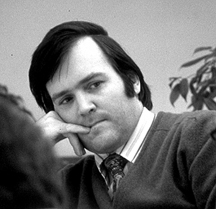 Born in 1939, Anson's parents helped run the farm of his maternal grandparents, about 140 kilometers south-west of Saskatoon near Rosetown, Saskatchewan. The town's motto is, "The Heart of the Wheat Belt." In the fall, winter and early spring, the family would return to Saskatoon where his father taught school. In 1945, the farm was sold and Anson became a full-time resident in Saskatoon for the next fifteen years.
Born in 1939, Anson's parents helped run the farm of his maternal grandparents, about 140 kilometers south-west of Saskatoon near Rosetown, Saskatchewan. The town's motto is, "The Heart of the Wheat Belt." In the fall, winter and early spring, the family would return to Saskatoon where his father taught school. In 1945, the farm was sold and Anson became a full-time resident in Saskatoon for the next fifteen years.
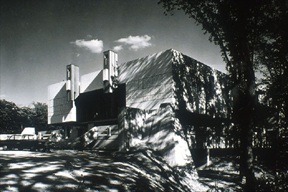 The first projects that Anson became aware of designed by Raymond Moriyama were the Halfway House, which had won a Massey Medal in 1961, and the Japanese Canadian Cultural Centre completed in 1963. He saw the same appreciation for materials and design in Ray's work that he learned to understand from Erikson and Thom. Anson knew his UBC classmate Takeuchi was working for Ray so he sent RM a letter.
The first projects that Anson became aware of designed by Raymond Moriyama were the Halfway House, which had won a Massey Medal in 1961, and the Japanese Canadian Cultural Centre completed in 1963. He saw the same appreciation for materials and design in Ray's work that he learned to understand from Erikson and Thom. Anson knew his UBC classmate Takeuchi was working for Ray so he sent RM a letter.
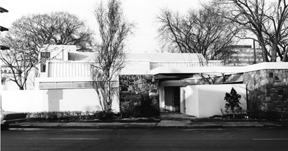 For the first week there were no windows in either the Upper or Lower Studio, only frames with loose sheets of plastic, so a security guard was hired to watch the building overnight. There were no finishes on the walls and floors. Ray was working with Mary Sabat and Mrs. C. in the Large Conference Room, which was part of an earlier addition, among a pile of furniture. After enduring the mess for two months construction was finally complete near the end of the summer.
For the first week there were no windows in either the Upper or Lower Studio, only frames with loose sheets of plastic, so a security guard was hired to watch the building overnight. There were no finishes on the walls and floors. Ray was working with Mary Sabat and Mrs. C. in the Large Conference Room, which was part of an earlier addition, among a pile of furniture. After enduring the mess for two months construction was finally complete near the end of the summer.
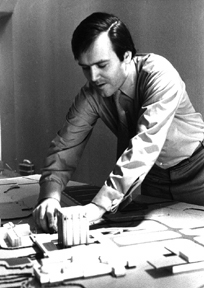 In the mid to late 1970's, he worked on the Metro Toronto Reference Library with Ray and Joni, and closely with the people from the Library including Gordon Barhydt and Marjorie MacLeod. New city planning and zoning bylaws were coming into effect and the design had to be adapted to suit the revised criteria. In the late 1970's, other significant projects for Anson were the London Regional Art Gallery, where the project was developed in close collaboration with local artists and the community, Peterborough Public Library and the Good Sheppard Church.
In the mid to late 1970's, he worked on the Metro Toronto Reference Library with Ray and Joni, and closely with the people from the Library including Gordon Barhydt and Marjorie MacLeod. New city planning and zoning bylaws were coming into effect and the design had to be adapted to suit the revised criteria. In the late 1970's, other significant projects for Anson were the London Regional Art Gallery, where the project was developed in close collaboration with local artists and the community, Peterborough Public Library and the Good Sheppard Church.
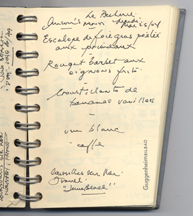
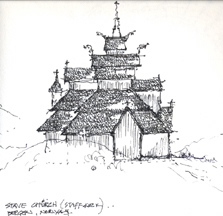 We have all heard the tales of Anson's extensive travels and adventures. Stories of Australia, New Zealand, Spain, Scandinavia, or Vancouver Island including Victoria and Tofino. You may wonder how he remembers meals he had long ago in far away places - he takes note of them in his sketchbook! Drawings of historic or interesting buildings and landmarks can be found alongside a detailed breakdown of the memorable meal of the day.
We have all heard the tales of Anson's extensive travels and adventures. Stories of Australia, New Zealand, Spain, Scandinavia, or Vancouver Island including Victoria and Tofino. You may wonder how he remembers meals he had long ago in far away places - he takes note of them in his sketchbook! Drawings of historic or interesting buildings and landmarks can be found alongside a detailed breakdown of the memorable meal of the day.
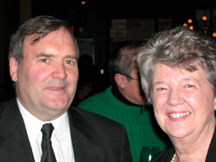 We all have shared in his experiences and memories or heard them described including playing shuffle board or leading the "boat races" at long lost Morrissey Tavern, fish and chips at the Duke while sparring with the waitress, a pint of beer or a dessert at the Pilot, carving up the haggis on Robbie Burns Day, "kitty-corner" at Broadview and Queen Street East inquiring about just how the coconut cream pie was made (is the coconut in the filling or sprinkled on top?), being ejected from the Royal Canadian Curling Club on ladies night, sampling wings at the Anchor Bar or ordering a Beef on Weck covered in road salt at "The Aud" in Buffalo. Our need for HB pencils should also drop considerably as he hangs up his instrument of choice.
We all have shared in his experiences and memories or heard them described including playing shuffle board or leading the "boat races" at long lost Morrissey Tavern, fish and chips at the Duke while sparring with the waitress, a pint of beer or a dessert at the Pilot, carving up the haggis on Robbie Burns Day, "kitty-corner" at Broadview and Queen Street East inquiring about just how the coconut cream pie was made (is the coconut in the filling or sprinkled on top?), being ejected from the Royal Canadian Curling Club on ladies night, sampling wings at the Anchor Bar or ordering a Beef on Weck covered in road salt at "The Aud" in Buffalo. Our need for HB pencils should also drop considerably as he hangs up his instrument of choice.